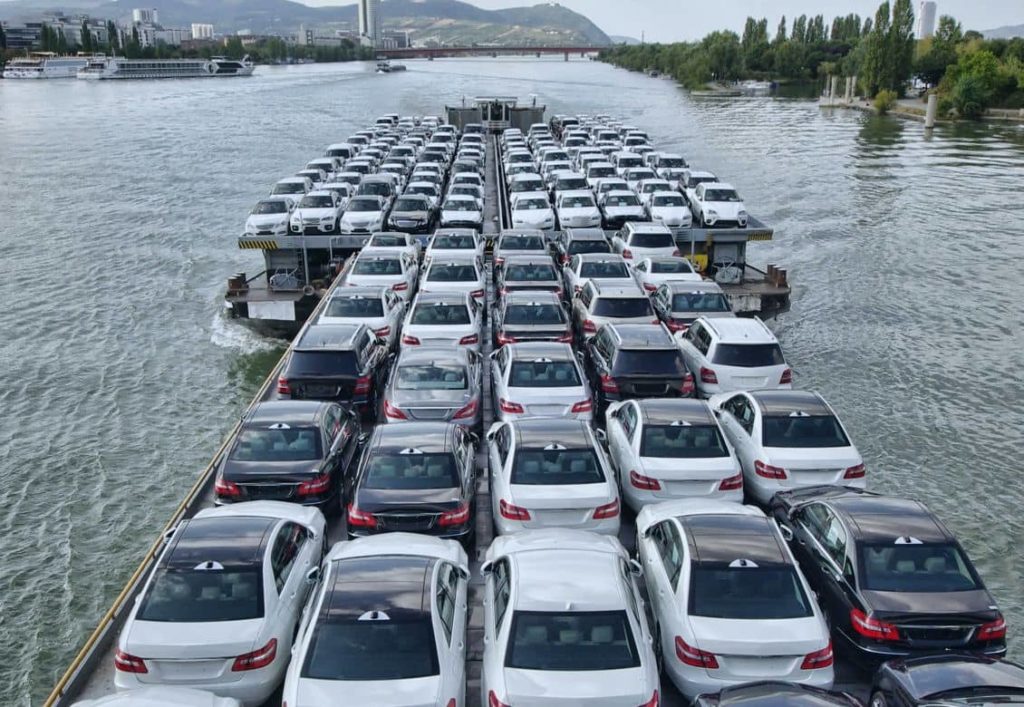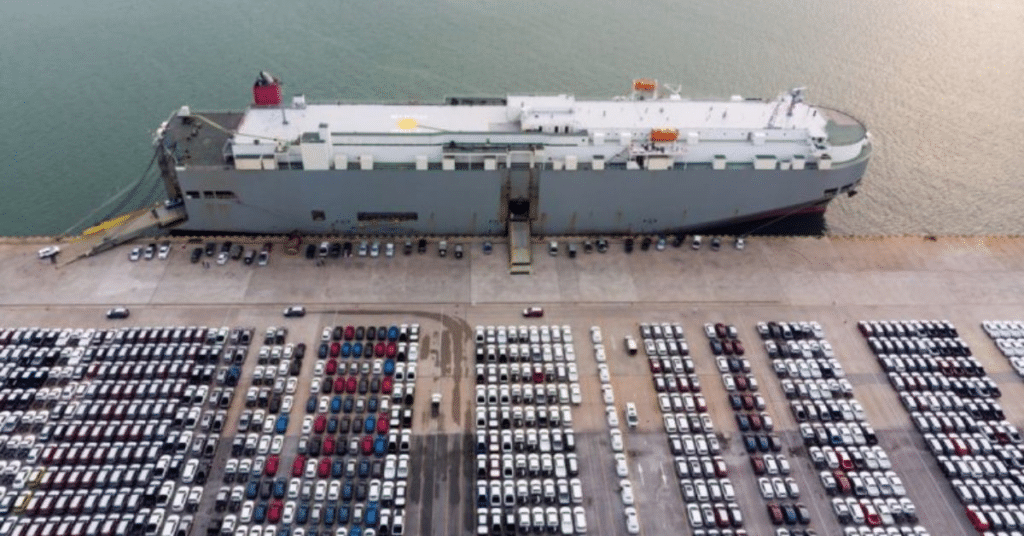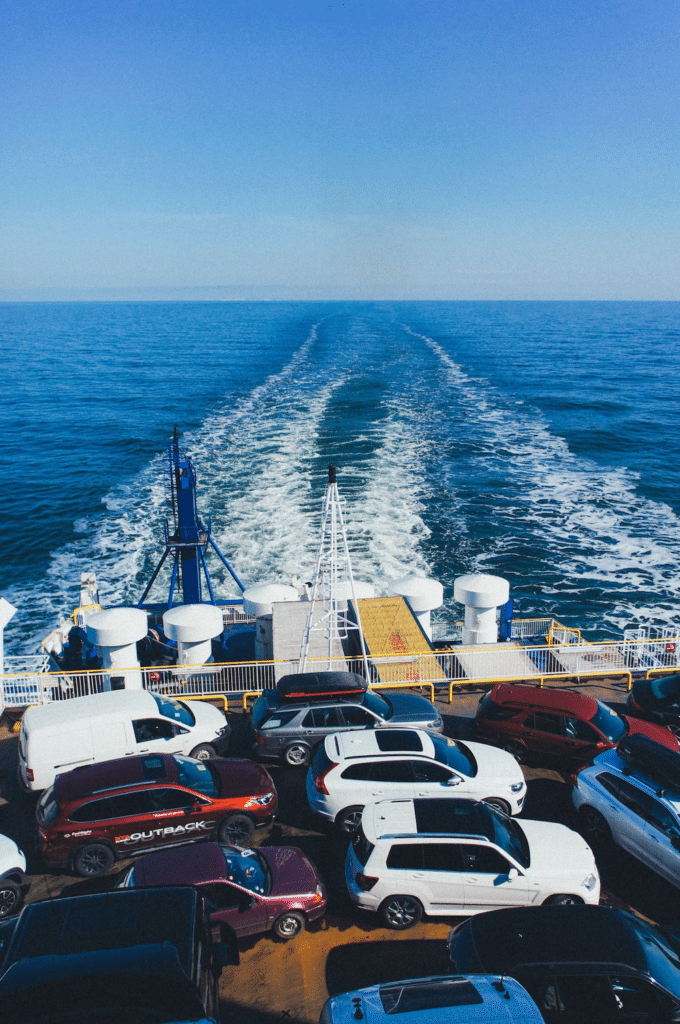How Are Cars Loaded Onto Ships? (Detailed guide)
Loading cars onto ships is a precise and well-coordinated process that ensures the safe and efficient transportation of vehicles across the seas. Various methods and equipment are employed to facilitate the loading procedure.
One common method used is the roll-on/roll-off (RoRo) technique. RoRo vessels are equipped with specialized ramps or platforms that allow vehicles to be driven directly onto the ship’s deck. This method eliminates the need for cranes or lifting equipment, streamlining the loading process.
Additionally, some vehicles are transported via containerized shipping. In this method, cars are securely placed inside standardized shipping containers, which are then loaded onto the ship using cranes or other lifting equipment. This provides an extra layer of protection for the vehicles during transit.
Throughout the loading process, utmost care is taken to ensure that vehicles are properly positioned and secured. Straps, wheel chocks, and braces are used to prevent any movement or damage during the voyage.
By employing these meticulous loading procedures, car shipping companies ensure that vehicles are loaded onto ships safely and efficiently, guaranteeing a smooth and secure journey to their destination.
How Are Cars Shipped by Sea?
Shipping cars by sea is a complex process that involves several key steps to ensure the safe and efficient transport of vehicles. Here is a general overview of how cars are shipped by sea:
- Booking and Documentation: The process begins with the car owner or shipping company booking space on a suitable vessel. Necessary documentation, including ownership papers, insurance, and export/import paperwork, is prepared.
- Vehicle Preparation: Cars are inspected, and any personal belongings or loose items are removed. The fuel tank is typically kept at a quarter full, and the battery may be disconnected to prevent draining during transit.
- Loading: Cars are loaded onto the ship using specialized equipment such as ramps or lifts. Different methods may be used, such as roll-on/roll-off (RoRo), where cars are driven onto the ship, or containerization, where vehicles are secured inside shipping containers.
- Securing and Stowing: Once onboard, cars are secured using straps, braces, or wheel chocks to prevent movement during the voyage. They are stowed in designated areas on the cargo ship, considering factors like weight distribution and stability.
- Transit and Tracking: The cargo ship sets sail, and during the transit, the progress of the vessel can be tracked using advanced tracking systems. Regular communication and updates are provided by the shipping company.
- Unloading: Upon arrival at the destination port, cars are carefully unloaded from the ship using the same methods employed during loading. Vehicles are inspected for any damage or issues that may have occurred during transit.
Shipping cars by sea require meticulous planning, adherence to safety protocols, and the expertise of shipping professionals. By following these steps, cars can be transported across vast distances, ensuring they arrive at their destination safely and efficiently.
Choose The Best Car Shipping Company For Shipping Cars By Sea
When it comes to shipping cars by sea, choosing the right car shipping company is crucial to ensure a smooth and reliable transportation process. Here are some key factors to consider when selecting the best car shipping company:
- Experience and Reputation: Look for a company with extensive experience and a solid reputation in the car shipping industry. Check customer reviews and ratings to gauge their reliability and professionalism.
- Services Offered: Evaluate the range of services offered by the company, such as door-to-door delivery, insurance coverage, tracking capabilities, and customs clearance assistance. Ensure they provide the specific services you require.
- Licensing and Insurance: Verify that the company holds the necessary licenses and certifications to operate as a car shipping service provider. Additionally, confirm that they have appropriate insurance coverage to protect your vehicle during transit.
- Pricing and Transparency: Request quotes from multiple companies and compare their pricing. Look for transparency in their pricing structure and ensure there are no hidden fees or charges.
- Customer Support: Consider the level of customer support provided by the company. Prompt and responsive communication is essential to address any concerns or inquiries throughout the shipping process.
By considering these factors, you can choose the best car shipping company that meets your specific needs, ensuring the safe and reliable transport of your vehicle by sea.
Everything You Need To Know About Car Carrier Ships
Car carrier ships fall, also known as auto car carriers or car transporters, are specialized vessels designed to transport large numbers of vehicles across the sea. These ships play a crucial role in the global automotive logistics industry, allowing for efficient and safe transportation of cars on a large scale.
Pure car carrier ships come in various sizes, ranging from smaller vessels capable of carrying a few hundred cars to massive ships that can transport thousands of vehicles. They are equipped with multiple decks, each accommodating rows of vehicles. The decks are designed with adjustable ramps or platforms to facilitate the loading and unloading of cars.
To ensure the safety of the vehicles during transit, the largest pure car carrier pcc ships have sophisticated systems in place. These include securing mechanisms such as wheel chocks, straps, and braces that hold the cars in place and prevent shifting or damage. Some ships also offer enclosed decks or weatherproof covers to protect the vehicles from external elements.
Car carrier ships utilize efficient logistics and route planning to optimize transport times and reduce costs. They operate on established shipping routes, making scheduled stops at various ports to load and unload vehicles. This enables efficient distribution and delivery of cars to different regions around the world.
In conclusion, pure car truck carrier ships are essential for the transportation of cars across the sea. Their specialized design, advanced securing systems, and strategic logistics ensure the smooth and secure transport of vehicles on a large scale, supporting the automotive industry’s global supply chain.
Containerized Car Transport
Containerized car transport(enclosed car transport) is a popular method used to ship vehicles across land and sea. It involves placing cars inside specially designed shipping containers for secure and efficient transportation. This method offers several advantages, including enhanced protection and versatility.
When using containerized car transport, vehicles are loaded into containers at the pickup location. The containers provide a protective barrier, shielding the cars from external elements and potential damage during transit. They are designed to accommodate various vehicle sizes and types, ensuring a snug fit and minimizing movement during transport.
Containerized car transport also offers flexibility in terms of logistics. Multiple cars can be loaded into a single container, optimizing space utilization and reducing shipping costs. Additionally, containers can be easily transferred between different modes of transportation, such as trucks, trains, and ships, providing a seamless and integrated transport solution.
Furthermore, containerized car transport simplifies customs procedures as the containers can be sealed and processed as a single unit. This streamlines the documentation and inspection process, making it more efficient and time-saving.
Overall, containerized car transport is a reliable and secure method for shipping vehicles. It provides added protection, flexibility, and convenience, making it a preferred choice for individuals and businesses involved in the automotive industry.
Container Ship Classes
Container ships are classified based on their size, capacity, and capabilities. These classifications help categorize and differentiate the various types of container vessels used in maritime trade. Here are three common classes of container ships:
- Feeder Vessels: Feeder’s vessels are smaller container ships primarily used for short-distance routes, transporting containers from regional ports to major hub ports. They have a capacity ranging from a few hundred to a few thousand TEUs (Twenty-Foot Equivalent Units) and are crucial for the distribution of cargo to smaller ports.
- Panamax and Post-Panamax Vessels: Panamax container ships are designed to fit through the Panama Canal’s original locks, with a maximum length, width, and draft. Post-Panamax vessels, on the other hand, exceed the size limits of the Panama Canal and are typically used for international routes. These ships have larger capacities, often ranging from 8,000 to 14,000 TEUs or more.
- Ultra Large Container Vessels (ULCVs): ULCVs are the largest class of container ships, capable of carrying over 14,000 TEUs. They are built to accommodate the growing demand for efficient only transport cars of goods on major trade routes. These mega-ships require deep-water ports and advanced infrastructure to handle their size and draft.
Container ship classes are essential for efficient planning, resource allocation, and optimizing the global shipping network. Each class serves specific purposes in meeting the demands of international trade, ensuring the smooth movement of goods across the seas.
What Is Roll On Roll Off?
Roll-on/roll-off (RoRo) is a method of cargo transportation that allows vehicles and machinery to be driven onto and off a specialized vessel, facilitating the easy loading and unloading of wheeled cargo. It is commonly used for transporting automobiles, trucks, buses, construction equipment, and other types of rolling stock.
RoRo vessels are equipped with ramps or platforms that enable vehicles to be driven directly onboard, eliminating the need for cranes or lifting equipment. The vehicles are securely parked and lashed down to prevent movement during transit.
This method offers several advantages. Firstly, it is a time-efficient process as vehicles can be quickly loaded and unloaded, minimizing turnaround times. Secondly, RoRo reduces the risk of damage since vehicles are driven on and off under their own power, minimizing the handling involved. Additionally, the ability to transport large quantities of vehicles in a single voyage makes RoRo a cost-effective choice for shipping.
RoRo has revolutionized the transportation of wheeled cargo, providing a streamlined and efficient solution for shipping vehicles and machinery worldwide. Its simplicity and effectiveness have made it a preferred choice in the logistics industry, ensuring the swift and secure transportation of rolling stock.
Comparing Ocean Transport Options: RoRo vs Container
When it comes to ocean transport, two popular options for shipping cargo are roll-on/roll-off (RoRo) and containerized transport. While both methods have their advantages, understanding their differences can help determine which is better suited for specific shipping needs.
RoRo transport is ideal for wheeled cargo such as cars, trucks, and heavy machinery. Vehicles are driven directly onto specialized vessels using ramps or platforms. RoRo offers fast loading and unloading times, minimizing handling and reducing the risk of damage. It is cost-effective for high volumes of vehicles and doesn’t require the additional expense of containerization.
Containerized transport, on the other hand, involves placing goods in standardized shipping containers. It provides more flexibility for a variety of cargo types and sizes, offering protection from external elements. Containers can be easily transferred between different modes of transportation, streamlining logistics.
Choosing between RoRo and containerized transport depends on the nature of the cargo and specific requirements. RoRo is efficient and cost-effective for wheeled cargo, while containerization offers versatility and protection for a wider range of goods. Understanding the unique advantages of each method helps make informed decisions and ensures efficient transportation across the seas.
Car Carrier Design and Build
Car carriers, also known as car transporters or auto-car carriers, are specialized vessels designed to transport vehicles efficiently and securely. The design and build of car carriers take into account specific requirements to ensure the safe and smooth transport of cars.
Car carrier ship vessels feature multiple decks with adjustable ramps or platforms that allow vehicles to be driven on and off the ship easily. These ramps are designed with gentle slopes to accommodate different vehicle types and sizes, minimizing the risk of damage during loading and unloading.
The decks of car carriers are equipped with securing mechanisms such as wheel chocks, straps, and braces. These ensure that vehicles remain stable and stationary throughout the voyage, even when encountering rough sea conditions. Some car carriers have weatherproof covers or enclosed decks for added protection against external elements.
To optimize space and maximize capacity, car carriers often have a design that allows for efficient stacking and arrangement of vehicles. They are built to accommodate various vehicle sizes, from sedans to larger SUVs and trucks.
Overall, the design and build of car carriers prioritize the safety and protection of vehicles during transport. With their specialized features and considerations, car carriers play a crucial role in the automotive logistics industry, facilitating the seamless movement of vehicles across land and sea.
FAQs
How Much Do Car Shipping Containers Cost?
The cost of car shipping containers can vary depending on several factors. The size and type of container, the distance of the shipment, and the additional services required all contribute to the overall cost. On average, car shipping containers can range from a few hundred to several thousand dollars. It’s recommended to request quotes from shipping companies to get an accurate estimate based on your specific needs. Factors like container size, destination, and any custom requirements will be considered when determining the final cost. It’s advisable to compare prices and services offered by different shipping companies to ensure you get the best value for your car shipping needs.
How Do Car Shipping Containers Work?
Car shipping containers provide a secure and efficient method for transporting vehicles. These containers are typically made of durable materials and designed to accommodate different car sizes. Cars are driven or loaded into the containers, which are then securely sealed. The containers protect vehicles from external elements during transit, such as weather conditions and potential damage. They are often stacked and stowed in the cargo hold of a ship, using specialized equipment. Car shipping containers ensure the safety of wheeled vehicles by preventing movement and minimizing the risk of scratches or collisions. Upon arrival, the containers are unloaded, and the cars can be retrieved.
How Do Cargo Ships Transport Cars Securely?
Cargo ships employ various measures to ensure the secure transportation of cars. Roll-on/roll-off (RoRo) vessels have specialized ramps and decks where cars can be driven directly on and off the ship, reducing the risk of damage. Car carriers may have adjustable securing mechanisms like wheel chocks, straps, and braces to hold vehicles in place during transit, minimizing movement. Containerized shipping provides an extra layer of protection, with cars securely placed inside standardized shipping containers. These containers are sealed and stacked carefully to prevent shifting or damage. Overall, cargo ships prioritize the safety of cars by utilizing secure loading methods and securing mechanisms to ensure a secure voyage.
How Do I Move Car Shipping Containers?
Moving car shipping containers requires specialized equipment and expertise. Generally, the process involves using heavy-duty trucks equipped with specialized trailers or chassis designed to carry shipping containers. These car truck carriers are capable of safely hauling containers from one location to another. Shipping companies or logistics providers typically handle the transportation of car shipping containers, coordinating the movement and ensuring proper handling and security. It’s essential to consult with a reputable shipping or logistics company to arrange the appropriate transport for your car shipping container needs, ensuring a smooth and efficient relocation process.









